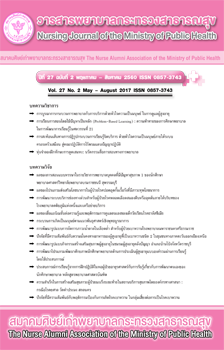การพัฒนารูปแบบกิจกรรมสร้างเสริมสุขภาพผู้สูงอายุในชมรมผู้สูงอายุ คลังปัญญา อำเภอบ้านโป่ง จังหวัดราชบุรี
Main Article Content
Abstract
บทคัดย่อ
การวิจัยและพัฒนามีวัตถุประสงค์ 1) ศึกษาสภาพปัญหาและความต้องการกิจกรรมสร้างเสริมสุขภาพในชมรมผู้สูงอายุคลังปัญญา 2) พัฒนารูปแบบกิจกรรมสร้างเสริมสุขภาพในชมรมผู้สูงอายุคลังปัญญา และ 3) ศึกษาประสิทธิผลของรูปแบบกิจกรรมสร้างเสริมสุขภาพในชมรมผู้สูงอายุ กลุ่มตัวอย่าง ระยะที่ 1 แกนนำชมรมผู้สูงอายุคลังปัญญา จำนวน 26 ราย ระยะที่ 2 ประกอบด้วย แกนนำชมรมผู้สูงอายุคลังปัญญาฯ อาจารย์จากวิทยาลัยพยาบาลฯ และเจ้าหน้าที่โรงพยาบาลส่งเสริมสุขภาพ รวม 28 ราย ระยะที่ 3 สมาชิกชมรมผู้สูงอายุ จำนวน 55 ราย โดยคัดเลือกแบบเจาะจง เครื่องมือการวิจัย ได้แก่ 1) แนวทางสนทนากลุ่มเพื่อศึกษาสภาพปัญหาและความต้องการกิจกรรมสร้างเสริมสุขภาพ 2) แนวทางสนทนากลุ่มเพื่อพัฒนารูปแบบฯ 3) แบบสอบถามความรู้ พฤติกรรมสุขภาพ และความพึงพอใจต่อกิจกรรมการสร้างเสริมสุขภาพ ดัชนี ความตรงเชิงเนื้อหาเท่ากับ .98-1.00 และค่าสัมประสิทธิ์ครอนบาคอัลฟาเท่ากับ .80-.94 วิเคราะห์ข้อมูล เชิงปริมาณ ใช้สถิติพรรณนาและสถิติทดสอบที ข้อมูลเชิงคุณภาพ โดยวิเคราะห์เนื้อหา ผลการวิจัย ระยะที่ 1 พบว่ากิจกรรมสร้างเสริมสุขภาพไม่เป็นรูปธรรม ไม่ต่อเนื่องและไม่ครอบคลุมมิติของการสร้างเสริมสุขภาพ ระยะที่ 2 รูปแบบกิจกรรมสร้างเสริมสุขภาพ ได้แก่ การประเมินภาวะสุขภาพ การให้ความรู้โดยใช้การเสริมสร้างพลังอำนาจและการแลกเปลี่ยนความรู้ระหว่างชมรม มีการดำเนินกิจกรรมสร้างเสริมสุขภาพเสริมอย่างต่อเนื่องในวันประชุมประจำเดือน ระยะที่ 3 พบว่า หลังการใช้รูปแบบผู้สูงอายุมีความรู้และพฤติกรรมสุขภาพดีกว่าก่อนใช้รูปแบบอย่างมีนัยสำคัญทางสถิติที่ระดับ .05 มีค่าเฉลี่ยเท่ากับ 23.76 (SD = 1.67) และ 3.65 (SD = 0.65) ตามลำดับและมีความพึงพอใจต่อกิจกรรมสร้างเสริมสุขภาพ ในระดับมาก โดย มีค่าเฉลี่ยเท่ากับ 4.72 (SD = 0.49)
The Development of a Health Promotion Activity Model for Elderly in the Ban Pong Elderly Klungpunya Club, Ratchaburi Province
hitichaya Chalardlon*
Sutreeporn Moolsart**
Wannarut Lawang***
Abstract
This research and development study aimed to: 1) identify the problems and needs of health promotion activities, 2) develop a model of health promotion activity of Klungpunya elderly club, and 3) examine the effectiveness of the health promotion activity model for the Klungpunya elderly club. The sample was divided according to the study phases; 1) a sample consisted of 26 elderly leaders; 2) a sample consisted of 28 people including 26 leaders of elderly clubs, a nursing instructor and a nurse from the health promotion hospital; and 3) a sample consisted of 55 elderly members of the elderly club. Samples in all phases were selected by purposive sampling. The research tools comprised: 1) focus group guidelines for the study of problems and needs, 2) focus group guidelines for model development, and 3) questionnaires of knowledge, health promotion behaviors, and satisfaction towards health promotion activities. Content validity indexes were .98-1.00 and the reliability coefficients were .80- .94. Quantitative data were analyzed by descriptive statistics and t-tests. Qualitative data were analyzed by content analysis. The results from Phase 1 showed that the health promotion activities of the elderly club were not well established and lacked continuity. Moreover, all dimensions of health promotion were not covered. During Phase 2, the model of health promotion activities comprised of health assessment, training to use empowerment and knowledge sharing between the networks, and maintaining the health promotion activities in monthly meetings. From the final phase, after model implementation, knowledge and health behaviors of elderly members were significantly higher than before implementation (p<.05) the mean was 23.76 (SD=1.67) and 3.65 (SD=0.65), respectively. The elderly were satisfied with the health promotion activities, with a high level average score being 4.72 (SD=0.49).
* Student the Degree of Master of Nursing Science in Community Health Nurse Practitioner School of Nursing Sukhothai Thammathirat Open University, e-mail : tutitichaya@gmail.com
** School of Nursing, Sukhothai Thammathirat Open University
*** Nursing faculty, Burapha University
Article Details
บทความและรายงานวิจัยในวารสารพยาบาลกระทรวงสาธารณสุข เป็นความคิดเห็นของ ผู้เขียน มิใช่ของคณะผู้จัดทำ และมิใช่ความรับผิดชอบของสมาคมศิษย์เก่าพยาบาลกระทรวงสาธารณสุข ซึ่งสามารถนำไปอ้างอิงได้

